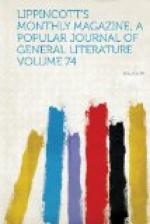Next to the mangosteen I should name the custard-apple (Anona squamosa), a rich and delicate fruit of the form and dimensions of a medium-sized quince, but made up of lesser cones, each with its apex directed toward the centre, and each containing a smooth black seed. The pulp is pure white, about the consistency of a baked custard, and in flavor very like strawberries and cream.
The delicious soursap is very similar to the custard-apple, but of larger size and slightly acid in taste. The bearded, rosy rambustan (Nephelium lappaceum) looks like a mammoth strawberry, but when the outer hairy covering has been removed a semi-transparent pulp is revealed, in taste so similar to our best Malaga grapes that a blind man would be unable to distinguish them.
Pineapples are good and abundant all over South-eastern Asia, but are in their perfection at Singapore and Malacca, weighing frequently four pounds or more. Passing, one warm afternoon, along the Singapore bazaar, I noticed a Chinese fruit-dealer who had among other delicacies outspread before him the largest and finest pineapples I had ever seen. As I inquired the price, the Celestial, after a long harangue on the extraordinary excellence of his wares, and the trouble he had taken to obtain them, expressed a hope that he should not be considered extortionate in selling them so very high, the price demanded for a whole four-pound pineapple, peeled, sliced, and ready for eating, being the equivalent of half a cent! The ordinary, medium-sized fruit could be purchased, he knew, at one-fifth of that sum, and his conscience, no doubt, was chiding him for extortion.
One of the most singular-looking fruits is the jack-fruit (Artocarpus integrifolia), growing in all its immensity of thirty or forty pounds weight directly out of the largest branches or on the stem of the huge tree. Externally, it has a rough, pale-green coat: internally, it has a luscious, golden-hued pulp, in which are embedded a dozen or more smooth, oval seeds about the size of large chestnuts, which they strikingly resemble in flavor.
The mango (Mangifera Indica) is a drupe of the plum kind, four or five inches long, and three at least in diameter. Greenish-colored outside, and not very inviting, you are most agreeably surprised at the rare, rich flavor of the bright yellow pulp that adheres like the clinging peach to a large flat seed.
The gamboge tree (Stalagmitis Cambogioides) grows luxuriantly in Siam, and also in Ceylon. It has small narrow, pointed leaves, a yellow flower, and an oblong, golden-colored fruit. Even the stem has a yellow bark, like the gamboge it produces. The drug is obtained by wounding the bark of the tree, and also from the leaves and young shoots. The natives say that they have sold it to white foreigners for hundreds of years past; and we know it was introduced into Europe early in the seventeenth century.




